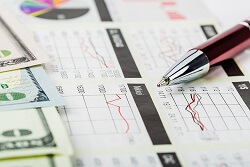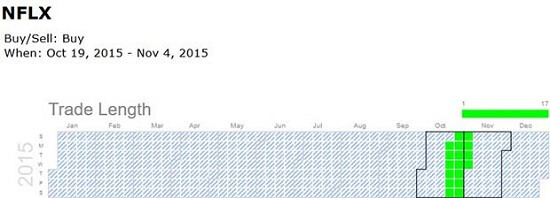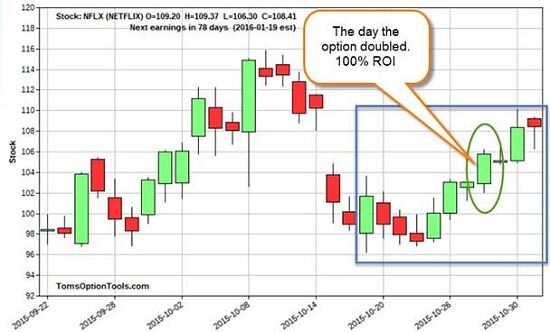There is an old adage that traders are told to live by that goes, "Plan your trade and trade your plan."
There should be a follow-up to that one that says, "Stick to your plan no matter what."
You would think that last adage is implied in the first one, but beginning traders always seem to get something in their head that makes them change their original trading plan. Even more experienced traders veer from time to time.
I can speak from my early days of trading experience when I say changing your plan mid-trade ALWAYS ends up reinforcing one lesson: that you should have stuck with your original trade plan all along.
Every master trader has learned, probably the hard way, to build a simple, effective trade plan and stick to it no matter what. It's pure gold.
 Today, I'm going to show you how to do just that using a case study straight from Money Calendar...
Today, I'm going to show you how to do just that using a case study straight from Money Calendar...
When setting up a trade, there are some things traders should have in mind that need to be done before they invest their first dollar. First, you must determine what kind of trade you want to make, which will most likely be decided by what kind of trader you are.
Since the majority of my trades are directional, I will focus on how to build a directional trade in the following example. But keep in mind that the underlying principals will work no matter what kind of trade you want to make.
For our purposes here, we want our targeted stock to make a move up or down, so it's important that we first make an assessment of the upcoming, short-term market direction.
You can use whatever tools you have at your disposal to make this determination, including any number of indicators (as we've talked about recently, the simple moving average is a great way to assess direction). I use Money Calendar, which gives me a calculation of how many of my top 250 stocks are showing the 90% probability of making a higher or lower price move.
Next, you'll assess how far you expect the stock to go and by what time frame. This will help you audit or manage your trade effectively. For our example here, let's assume your research indicates a three-point move higher in the underlying stock within the next few months.
Naturally, you'll want to buy call options with an expiration date a couple of months out.
But before you do, make sure you do one thing...
Determine Your Risk Ahead of Time
Before you buy your call options on the underlying stock that you expect will see a three-point move in the next few months, you have to determine your risk.
Some traders calculate their max position size using a percentage of their trading account. Typically, traders do not risk more than 2% of their trading capital on any one trade. Many traders risk far less. For Money Calendar trades, the rule is that we never risk more than $500 per trade. Whatever method or number you choose, just be consistent so that you can easily determine your position size for each trade.
Consider this example...
You have a $25,000 account and do not want to risk more than 2%, or $500, per trade. If the option contract you are considering is priced at $2.50, that means you can buy no more than two contracts. This assumes you will risk the full 100% invested on the trade. That, of course, is up to you.
If you want to buy more contracts without taking on more risk, all you have to do is use a stop loss on your position. For example, if you adhere to a 50% stop loss, then you could take on a position size of four contracts. Four contracts at $2.50 = $1,000 invested on the option trade (four contracts x 100 shares x $2.50 = $1,000), but your 50% stop loss will ensure, assuming you absolutely stick with your plan, that your risk remains at $500.
Once you determine your risk, you can buy your call options.
And what happens next is absolutely crucial...
Stick to Your Trading Plan
Now you've zeroed in on your stock, selected your call option, determined your risk, and placed your trade. The stock moves in your expected direction, jumping three points higher, and your call option is now showing a profit.
But you're excited at the prospect of your option showing gains, and you want MORE! So you hang on to the option because you have more time till expiration.
Then the stock reverses on you and goes back to breakeven. Or worse yet, a loss.
You had an assessment ahead of time showing you that a three-point move was all the stock had in it. You built your trade with that knowledge and/or expectation ahead of time and could have had the chance to follow that plan.
It's important to take profits when you hit your predetermined profit targets, especially with options. Remember, the fixed-time nature of options means that, at some point, time decay will begin to work against you, and your option will begin to quickly decline in value.
Let's take a look at a specific example using a recent trade from Money Calendar.
Case Study: NFLX
Here is the process for a trade on Netflix Inc. (Nasdaq: NFLX). I used Money Calendar for the week of Oct. 19-23 and saw a whole week of green, signifying a bullish week.

My assessment on NFLX was for it to move higher by at least five points, as it has done nine out of the last 10 years (90%), according to Money Calendar's data.
![]()
And I was able to determine the amount of time it would take because Money Calendar showed me it made these price moves over a 13-day period.

The action to take was as follows:

We targeted November Week 1 options that expired Nov. 6.
The limit price for this trade was $2.50. That means if you have a $500 risk threshold, you would be able to buy two contracts.
Here was the exit plan for this trade:

Here is a chart on what happened over the life of the trade:

You can see that the first three days after the trade was placed on Oct. 19 were all down days.
Some traders would think that is NOT the way they want their trade to start. They may fear even more down days to come and sell the options in a panic to eliminate further decline and be able to sleep at night.
But we didn't panic - we did our homework, created a great trade plan, and placed a good trade based on historical data from Money Calendar.
[mmpazkzone name="in-story" network="9794" site="307044" id="137008" type="4"]
We built our trade with certain expectations of what the stock could do and we stuck to your particular risk tolerances (for our Money Calendar trades, no more than $500 per trade) when we placed the trade. And if the prepared trader who builds his or her trades ahead of time with both "what ifs" assessed (what if it goes higher and what if it goes lower) did not want to have the full 2% at risk, they wouldn't have put this trade on in the first place.
But, having agreed ahead of time to the known risk, we stuck to our guns and rode this out to a 100% ROI on Oct. 28.
Follow us on Twitter @moneymorning.
The Long-Term Options Trading Strategy You Need to Know... For traditional buy-and-holders, the short-term, options-based way of trading can be overwhelming. Fear not! You can wet your feet with this long-term strategy. This method follows longer timeframes and comes with some pretty terrific benefits...
About the Author
Tom Gentile, options trading specialist for Money Map Press, is widely known as America's No. 1 Pattern Trader thanks to his nearly 30 years of experience spotting lucrative patterns in options trading. Tom has taught over 300,000 traders his option trading secrets in a variety of settings, including seminars and workshops. He's also a bestselling author of eight books and training courses.



